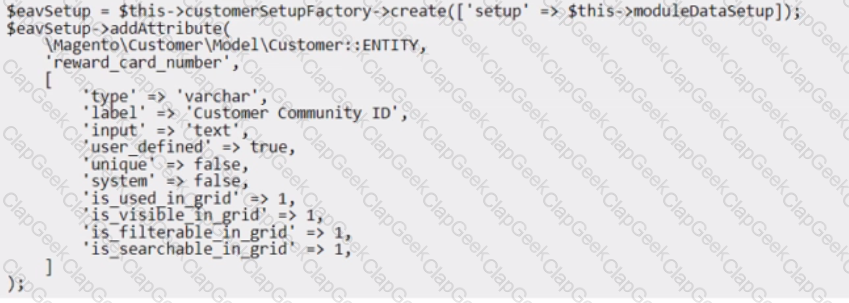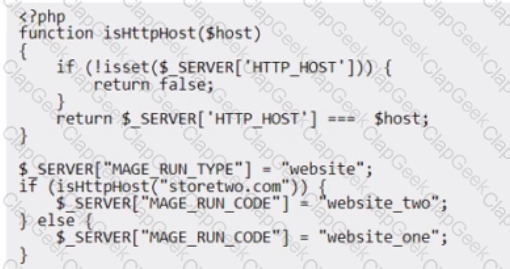An Adobe Commerce Architect needs to ensure zero downtime during the deployment process of Adobe Commerce on-premises. Which two steps should the Architect follow? (Choose two.)
A representative of a small business needs an Adobe Commerce Architect to design a custom integration of a third-party payment solution. They want to reduce the list of controls identified in their Self-Assessment Questionnaire as much as possible to achieve PCI compliance for their existing Magento application.
Which approach meets the business needs?
An Adobe Commerce Architect is creating a new GraphQL API mutation to alter the process of adding configurable products to the cart. The mutation accepts configurable product ID. If the given product has only one variant, then the mutation should add this variant to the cart and return not nullable Carttype. If the configurable product has more variants, then the mutation should return not nullable Conf igurableProduct type.
The mutation declaration looks as follows:

How should the Adobe Commerce Architect declare output of this mutation?
A)

B)

C)

A merchant is utilizing an out-of-the-box Adobe Commerce application and asks to add a new reward card functionality for customers. During the code review, the Adobe Commerce Architect notices the reward_card_number attribute setup created for this functionality is causing the customer attribute to be unavailable in the My account/My rewards page template.

What should be added to set the customer attribute correctly?
An Architect agrees to improve company coding standards and discourage using Helper classes in the code by introducing a new check with PHPCS.
The Architect creates the following:
• A new composer package under the AwesomeAgency\CodingStandard\ namespace
• The ruleset. xml file extending the Magento 2 Coding Standard
What should the Architect do to implement the new code rule?
A)

B)

C)

An Architect working on a headless Adobe Commerce project creates a new customer attribute named my_attribute. Based on the attribute value of the customer, the results of GraphQI queries are modified using a plugin. The frontend application is communicating with Adobe Commerce through Varnish by Fastly. which is already caching the queries that will be modified. The Adobe Commerce Fastly extension is installed, and no other modifications are made to the application.
Which steps should the Architect take to make sure the vcl_hash function of Varnish also considers the newly created attribute?
An Adobe Commerce Architect is supporting deployment and building tools for on-premises Adobe Commerce projects. The tool is executing build scripts on a centralized server and using an SSH connection to deploy to project servers.
A client reports that users cannot work with Admin Panel because the site breaks every time they change interface locale.
Considering maintainability, which solution should the Architect implement?
A company wants to build an Adobe Commerce website to sell their products to customers in their country. The taxes in their country are highly complex and require customization to Adobe Commerce. An Architect is trying to solve this problem by creating a custom tax calculator that will handle the calculation of taxes for all orders in Adobe Commerce.
Following best practices, how should the Architect add the taxes for all orders?
While reviewing a newly developed pull request that refactors multiple custom payment methods, the Architect notices multiple classes that depend on \Magento\Framework\Encryption\EncryptorInterface to decrypt credentials for sensitive data. The code that is commonly repeated is as follows:

The Architect needs to recommend an optimal solution to avoid redundant dependency and duplicate code among the methods. Which solution should the Architect recommend?
An Architect needs to integrate an Adobe Commerce store with a new Shipping Carrier. Cart data is sent to the Shipping Carrier's API to retrieve the price and display to the customer. After the feature isimplemented on the store, the API hits its quota and returns the error "Too many requests". The Shipping Carrier warns the store about sending too many requests with the same content to the API.
In the carrier model, what should the Architect change to fix the problem?
A single Adobe Commerce Cloud instance is set up with two websites (each with a single store view) with different domains.
• The default website is website_one, with store view store_one, and domain storeone. com.
• The second website is website_two, with store view store_two, and domain storetwo. com.
The magento-vars. php file is set up as follows to determine which website each request runs against:

When testing a new GraphQL integration, all requests returned data relating to the default website, regardless of the domain. What is causing this issue?
An Adobe Commerce store owner sets up a custom customer attribute "my.attribute".
An Architect needs to display additional content on the home page, which should display only to Customers with "my.attribute" of a certain value and be the same content for all of them. The website is running Full Page Cache.
With simplicity in mind, which two steps should the Architect take to implement these requirements? (Choose two.)


